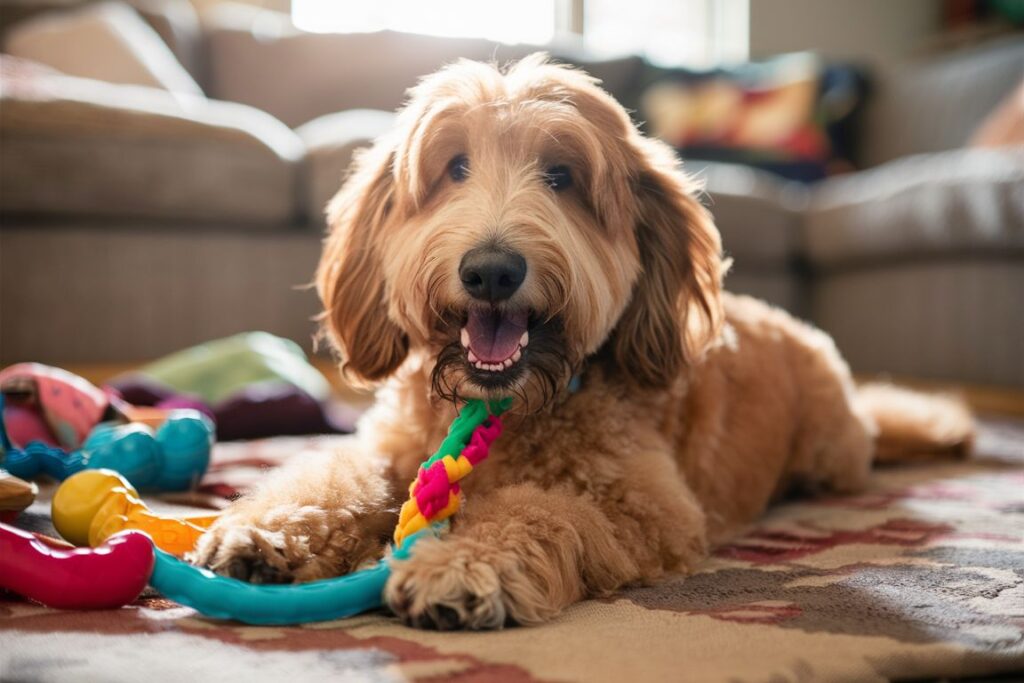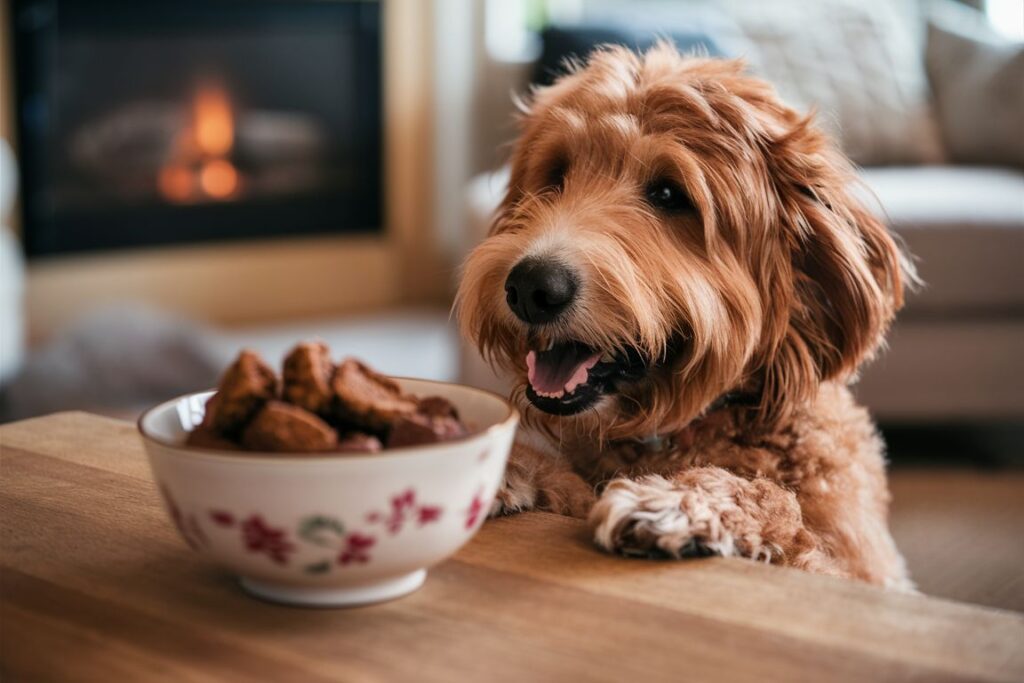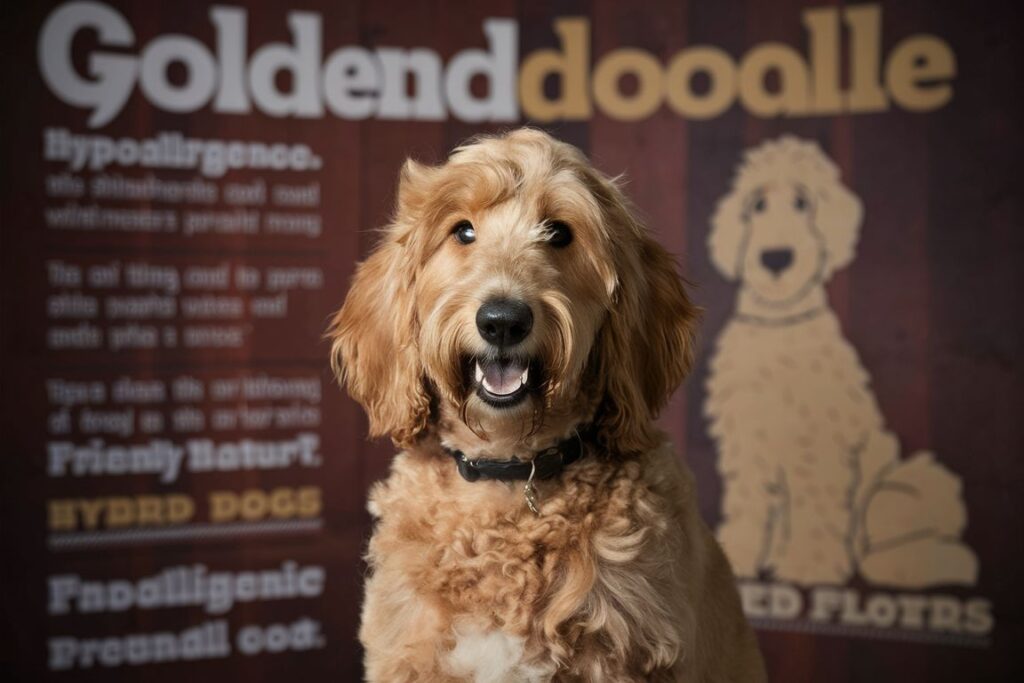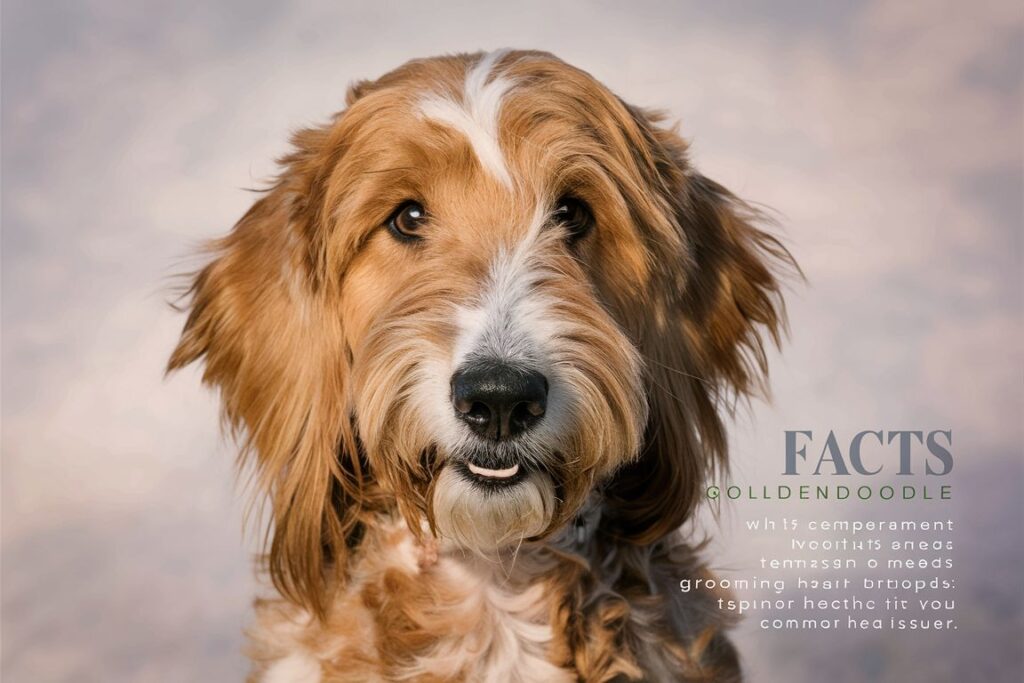Goldendoodle Straight Hair is gaining popularity due to its resemblance to Golden Retrievers and low shedding. Genetic factors determine their coat type, with first-generation (F1) Goldendoodles having a higher chance of straight hair.
Straight-haired Goldendoodles require less grooming, making them attractive for low-maintenance pet owners. Goldendoodles with straight hair provide a convenient, hypoallergenic option for dog enthusiasts.
Despite shedding, their manageable coats and charming appearance make them a popular choice. Understanding the genetic basis and grooming needs of Goldendoodle Straight Hair aids in informed decision-making for prospective owners.
Are straight haired Goldendoodles rare?
Straight-haired Goldendoodles, also known as flat-coat Goldendoodles, are less common than their curly-haired counterparts due to genetic factors favoring curly coats from Poodles. However, these straight-haired variants do occur naturally, particularly in specific generations or genetic combinations.
The occurrence of straight hair in Goldendoodles varies depending on breeding practices, with first-generation (F1) Goldendoodles having a higher likelihood. Despite their rarity, straight-haired Goldendoodles share the same friendly temperament as curly-coated ones, but require less grooming maintenance.
Although not as widespread, individuals interested in straight-haired Goldendoodles can still find them through diligent research and reputable breeders who prioritize genetic diversity and health. These charming companions offer a unique blend of traits, making them a delightful choice for potential dog owners.
What are some interesting facts about Goldendoodles?
Straight-haired Goldendoodles, also referred to as flat-coat Goldendoodles, are relatively less common than their curly-haired counterparts due to genetic influences favoring Poodle’s curly coats. However, these flat-coated variations occur naturally, particularly in specific breeding generations or genetic combinations.

The prevalence of straight hair in Goldendoodles varies based on breeding practices, with first-generation (F1) Goldendoodles showing a higher probability. Despite their rarity, straight-haired Goldendoodles exhibit the same friendly demeanor as their curly-coated counterparts but require lesser grooming.
Though not as abundant, enthusiasts seeking straight-haired Goldendoodles can still locate them through thorough research and reputable breeders focusing on genetic diversity and health. These delightful companions offer a unique combination of qualities, making them an appealing choice for prospective dog owners.
What is the lifespan of a straight hair Goldendoodle?
Lifespan Explanation:
The lifespan of a Goldendoodle Straight Hair typically ranges between 10 to 15 years, depending on various factors such as genetics, health care, and lifestyle.
Proper diet, exercise, and regular veterinary check-ups can contribute to a longer and healthier life for your pet. However, it’s essential to note that individual dogs may vary, and some may live shorter or longer lives based on their unique circumstances.
Factors Affecting Lifespan:
Several factors can influence the lifespan of a straight hair Goldendoodle, including genetics inherited from their parent breeds, such as Golden Retrievers and Poodles.
Providing a balanced diet, maintaining a healthy weight, and ensuring regular exercise can help promote longevity. routine vaccinations, preventive care, and prompt treatment of any health issues can contribute to extending your Goldendoodle’s lifespan.
Quality of Life:
Ensuring a high quality of life for your Goldendoodle Straight Hair involves meeting their physical, mental, and emotional needs. Providing a loving and stimulating environment, along with proper socialization and training, can enhance their overall well-being. Regular dental care, parasite prevention, and grooming also play vital roles in maintaining your Goldendoodle’s health and happiness throughout their lifespan.
Why is my Goldendoodle hair straight?
Why Goldendoodle Hair is Straight:
Goldendoodle Straight Hair can be straight due to genetic factors inherited from their parent breeds, particularly the absence of the Cu locus gene responsible for curly coats.
This gene, also known as the Curly Coat Gene, is often found in Standard Poodles, resulting in the curly coats typically associated with Goldendoodles. When a Goldendoodle lacks this gene, their hair remains straight, resembling the coat of a Golden Retriever.
Influence of Generations:
The likelihood of a Goldendoodle Straight Hair is influenced by its generation, with first-generation (F1) Goldendoodles having a higher chance of straight hair compared to subsequent generations.
Breeding practices and genetic combinations play a significant role in determining the coat type of Goldendoodle puppies. While F1 Goldendoodles may more closely resemble their Golden Retriever parent, later generations can still produce individuals with straight hair.
Grooming Considerations:
Goldendoodle Straight Hair typically require less grooming compared to their curly-haired counterparts. Their coats are easier to maintain and may only need occasional brushing to prevent matting and keep them looking tidy. Understanding the genetic basis behind straight-haired Goldendoodles can help owners better care for their pets and appreciate their unique characteristics.
What age is considered old for a Goldendoodle?
Goldendoodles are considered seniors when they reach around 7 to 10 years old, depending on various factors such as size, genetics, and overall health. Larger Goldendoodles tend to age faster than smaller ones. Signs of aging in Goldendoodles may include decreased energy levels, gray hairs, and changes in mobility.
As Goldendoodles age, they may experience age-related health issues such as arthritis, dental problems, and vision or hearing loss. Regular veterinary check-ups become increasingly important to monitor their health and address any emerging issues promptly.
Owners can help their senior Goldendoodle Straight Hair stay active and comfortable through appropriate exercise, a balanced diet, and regular grooming. While aging is a natural process, senior Goldendoodles can still lead fulfilling lives with proper care and attention.
Adjustments to their environment and routine, such as providing soft bedding and modifying exercise intensity, can help accommodate their changing needs. With love and support from their owners, senior Goldendoodles can continue to bring joy and companionship well into their golden years.
At what age do Goldendoodles get their curls?
Goldendoodles typically start developing their curls around 6 to 9 months of age. This is when their puppy coat begins to transition into their adult coat. The exact timing can vary depending on genetic factors and individual growth rates.
Some Goldendoodles may start showing curls earlier, while others may take a bit longer to develop them. During the transition phase, owners may notice changes in the texture and appearance of their Goldendoodle’s fur.
Straight or wavy puppy fur may start to become more curly as the adult coat grows in. It’s important to be patient during this stage, as the final curl pattern may take several months to fully develop.
The time a Goldendoodle reaches 1 to 2 years of age, their curls should be well-established. However, it’s important to note that not all Goldendoodle Straight Hair will have tight curls.
Some may have looser waves, while others may have more defined curls. Regular grooming and care can help maintain the health and appearance of your Goldendoodle’s coat as their curls continue to develop.
Read This Blog:https://petplacid.com/the-importance-of-crate-training-how-long-should-you-let-your-puppy-cry/
What do Goldendoodles love the most?
Goldendoodle Straight Hair are known for their affectionate nature and love for companionship. They thrive on spending time with their human family members, enjoying cuddles, and being part of everyday activities.
Whether it’s lounging on the couch or going for a walk, Goldendoodles cherish the time they spend bonding with their owners.

Another thing Goldendoodles love is playtime. These energetic and playful dogs enjoy engaging in games and activities that stimulate their minds and bodies.
Whether it’s playing fetch in the backyard, going for a swim, or participating in agility training, Goldendoodles thrive on physical and mental stimulation. The Goldendoodles have a strong social nature and enjoy interacting with other animals.
Whether it’s meeting new dogs at the park or playing with household pets, Goldendoodle Straight Hair are typically friendly and sociable creatures. They also enjoy the company of children, making them great family pets who love nothing more than being surrounded by loved ones.
What problems are Goldendoodles prone to?
Goldendoodle Straight Hair, like any breed, are prone to certain health issues. One common problem is hip dysplasia, which can cause discomfort and mobility issues for the dog. Regular vet check-ups and proper exercise can help manage this condition and ensure the dog’s well-being.
Another issue that Goldendoodle Straight Hair may face is ear infections, especially due to their floppy ears that can trap moisture. Owners should regularly clean their dog’s ears and watch for signs of infection, such as redness or foul odor. Prompt treatment can prevent discomfort and further complications.
The Goldendoodles may experience skin allergies or sensitivities, leading to itching, redness, or hot spots. Providing a balanced diet, regular grooming, and using hypoallergenic products can help alleviate these issues. It’s essential for owners to monitor their dog’s skin health and consult with a veterinarian if problems arise.
Can Goldendoodles be left alone?
Goldendoodle, like any other dog breed, may experience separation anxiety if left alone for long periods. However, their ability to be left alone depends on various factors, including their individual temperament, training, and socialization.
Some Goldendoodles may tolerate being alone better than others, especially if they’ve been trained gradually to spend time alone from a young age.
To help Goldendoodles cope with being left alone, it’s essential to provide them with sufficient mental and physical stimulation. This can include interactive toys, puzzle feeders, and regular exercise to keep them engaged and prevent boredom.
Crate training or gradually increasing alone time can help desensitize them to being away from their owners. The whether a Goldendoodle can be left alone depends on the specific needs of the dog and the owner’s lifestyle.
While some Goldendoodles may thrive in environments where they’re left alone for short periods, others may struggle and require more companionship. It’s essential for owners to assess their dog’s individual needs and provide appropriate training and enrichment to ensure their well-being when left alone.
What is the rarest Goldendoodle color?
The rarest Goldendoodle color is typically considered to be merle. Merle Goldendoodles have a unique coat pattern characterized by splotches or patches of color on a lighter base. These patches can vary in size and distribution, creating a distinctive and eye-catching appearance.
Due to the rarity of the merle gene in both Golden Retrievers and Poodles, merle Goldendoodles are less common than other color variations. Merle Goldendoodles can come in various colors, including blue merle, red merle, and chocolate merle.
Blue merle Goldendoodles feature gray or blue patches on a lighter base, while red merle Goldendoodles have reddish or copper-colored patches. Chocolate merle Goldendoodles display chocolate-colored patches on a lighter background. Each merle variation adds to the uniqueness of these already rare and sought-after dogs.
While merle Goldendoodles are visually striking, prospective owners should be aware of potential health risks associated with the merle gene. Merle coloring is linked to a genetic mutation that can cause health issues such as deafness, blindness, and abnormalities in the eyes or ears.
Responsible breeders carefully screen for these health concerns and prioritize the well-being of their puppies, ensuring that merle Goldendoodle Straight Hair are not only beautiful but also healthy companions for their new families.
Why are Goldendoodles so expensive?
Goldendoodles are often considered expensive due to several factors. First, the breeding process requires careful selection of parent dogs with desirable traits such as hypoallergenic coats and gentle temperaments.
This selective breeding necessitates investment in high-quality breeding stock, veterinary care, and genetic testing to ensure healthy puppies. Additionally, reputable breeders prioritize proper socialization and early training for their puppies, adding to the overall cost.

The popularity of Goldendoodles contributes to their high price tag. As a sought-after designer breed, demand often exceeds supply, driving up prices. Moreover, reputable breeders prioritize ethical breeding practices and provide comprehensive health guarantees,
Which can further elevate the cost of acquiring a Goldendoodle puppy. Factors such as location and breeder reputation also influence pricing, with breeders in certain regions or with exceptional pedigrees commanding higher prices.
The ongoing costs associated with owning a Goldendoodle also contribute to their perceived expense. Beyond the initial purchase price, owners must consider expenses such as veterinary care, grooming, training, and supplies.
The factors such as the size, coat type, and lineage of the Goldendoodle can influence long-term care costs. Despite the initial investment, many owners find the companionship and joy provided by their Goldendoodle to be well worth the expense.
How do you groom a straight haired Goldendoodle?
Grooming a straight-haired Goldendoodle is relatively simple and requires regular brushing to maintain their coat’s health and appearance. Start by brushing your Goldendoodle’s coat at least once or twice a week using a pin brush or slicker brush to remove any loose hair and prevent matting.
Focus on brushing the entire body, including the legs, belly, and tail, to distribute natural oils and stimulate the skin. Next, bathe your Goldendoodle as needed, typically every 4-6 weeks, using a mild dog shampoo.
Be sure to rinse thoroughly to remove all traces of shampoo, as leftover residue can cause skin irritation. After bathing, gently towel dry your Goldendoodle and use a blow dryer on a low heat setting to finish drying their coat completely.
Trimming your Goldendoodle’s nails regularly is also essential to prevent overgrowth and discomfort. Use a quality pair of pet nail clippers to trim the nails, being careful not to cut too close to the quick.
Check your Goldendoodle’s ears regularly for signs of wax buildup or infection, and clean them using a dog-specific ear cleaner and cotton balls. By following these grooming practices, you can keep your straight-haired Goldendoodle looking and feeling their best.

Jackson is a seasoned professional in the field of pets, boasting four years of enriching experience. His expertise spans pet care, training, and health, ensuring insightful and reliable content for pet enthusiasts on our site.







